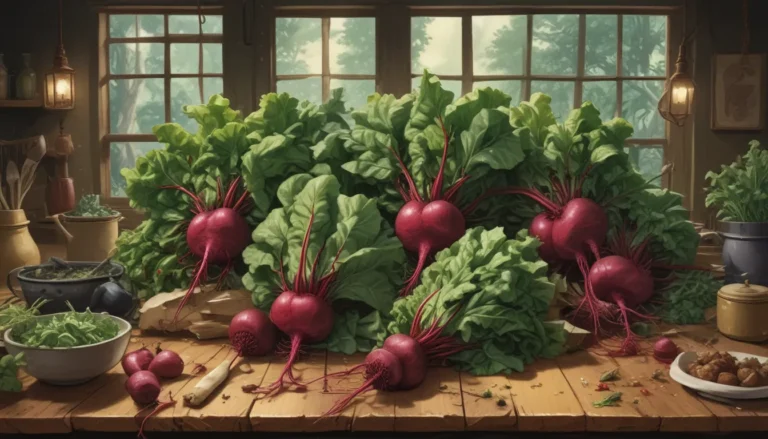Harvesting and Utilizing Stinging Nettle Root: A Comprehensive Guide

Stinging nettle, a beloved herb with a rich history of culinary and medicinal use, has been a cherished plant for millennia, revered across cultures worldwide. While many may be familiar with harvesting the leaves for cooking or the stems for textiles, the root is often overlooked as a valuable resource with unique medicinal properties.
In this extensive guide, we will explore the ins and outs of stinging nettle root – from its characteristics to its uses, and from the ideal harvesting time to processing and preserving techniques. Whether you are a seasoned gardener or a novice herbal enthusiast, there is valuable information here for you to uncover.
What Is Stinging Nettle Root?
Stinging nettle, scientifically known as Urtica dioica, is a perennial herbaceous plant characterized by its stinging hairs found along its stems and leaves. The plant spreads through rhizomes, forming a complex network underground.
The roots of stinging nettle are double-layered, comprising an upper layer of young runners and a deeper layer of thicker, fibrous roots. These roots are robust, easy to harvest, and possess specific medicinal properties distinct from other parts of the plant.
Uses for Nettle Root
Stinging nettle root extract is commonly utilized in over-the-counter supplements and herbal remedies, particularly those targeted for “men’s health” concerns. The root extract contains beta-sitosterol, a plant compound known for its ability to address urinary tract complications associated with benign prostatic hyperplasia (BPH), a common condition in men.
Several studies have highlighted the effectiveness of stinging nettle root in managing BPH symptoms, showcasing promising results comparable to conventional medications like finasteride. The plant’s therapeutic applications are backed by a history of clinical use, phytochemical investigations, and pharmacological studies.
To delve deeper into the world of stinging nettle leaves, refer to our comprehensive guide covering growing, using, and harvesting techniques.
A Note of Caution:
Before incorporating any nutritional or herbal supplements into your routine, always seek guidance from a healthcare professional. The information presented here is intended for educational purposes and not as medical advice.
When to Harvest
For optimal harvesting, target late fall or early spring when the plant’s energy shifts towards root development. In regions with milder climates, winter harvests may also be feasible. Timing is crucial to ensure maximum potency and quality in the harvested roots.
Spring harvesting should be undertaken before new shoots emerge, redirecting the plant’s energy towards growth above ground.
How to Harvest
Preparing for the harvest involves locating the rhizomes, buried approximately six inches underground in two distinct layers. Carefully excavate the roots, separating the young runners from the deeper, thicker roots.
Protective gear, a digging tool, and a mindful approach are essential during harvesting. Leave behind a portion of the roots to ensure regrowth and sustainability of the plant.
Processing and Preserving
After harvesting, thorough cleaning and preparation are vital to retain the quality of stinging nettle roots. A meticulous three-step washing process followed by drying facilitates preservation and storage for future use.
Drying Techniques:
- Cut the roots into small pieces for uniform drying.
- Employ a dehydrator or air-dry in a dry, shaded location.
- Properly dried roots can be used fresh or further processed for various applications.
Tincturing and Beyond:
Crafting medicinal tinctures from stinging nettle root involves steeping the roots in high-proof alcohol for several weeks. Additionally, the roots can be powdered, brewed as tea, or incorporated into topical applications.
The versatility of stinging nettle root extends beyond traditional applications, showcasing its significance in herbal medicine and wellness practices.
The Essence of Stinging Nettle Root
Incorporating stinging nettle root into your herbal repertoire opens up a world of possibilities for holistic well-being and natural remedies. Beyond the leaves and stems, the root provides a unique spectrum of medicinal benefits worth exploring.
As you embark on your harvesting journey, share your experiences and insights on utilizing stinging nettle root in the comments below. Your knowledge and discoveries contribute to a vibrant community of herbal enthusiasts.
Expand your herbal garden with additional medicinal plants by exploring guides on angelica, purslane, and plantain cultivation and care.
Copyright Disclaimer:
All information provided is for educational purposes and does not substitute medical advice. Consult a healthcare professional before initiating dietary changes or herbal supplement regimens.
Embrace the transformative power of stinging nettle root in your herbal endeavors, and let nature’s bounty enrich your holistic wellness journey.





